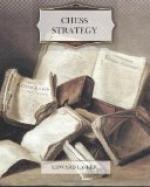which the greater mobility is the deciding factor. Although White has one pawn more, he can only win by reducing the mobility of the Black Rook through the following manoeuvre: 1. R-B2, R-Q2; 2. R-R2, R-R2. Now the Black Rook has only one move left, whilst the White Rook has the freedom of the Rook’s file. For instance, the Rook can be posted at R5 and prevent the Black King from attacking White’s King’s side pawns, whilst the White King makes for the R at R7 and effects its capture. If, on the other hand, the Black King tries to obstruct the way to the Queen’s side, White penetrates into the Black pawn position. Black cannot maintain the opposition because the White Rook has spare moves, the Black Rook none. e.g. 3. K-B3, K-Kt3; 4. R-R5, K-B3; 5. K-K4, K-K3; 6. R-R4, P-Kt3; 7. R-R5, K-Q3; 8. K-Q4, K-B3; 9. K-K5, and wins the pawns.
Having the move, Black would draw the game by: 1. ... R-Q7ch; 2. K-R3, R-R7. By placing his Rook behind the passed pawn he condemns the opposing Rook to inactivity, whilst his own is free to move on the Rook’s file. If now the White King comes up, he will in the end force the sacrifice of the Black Rook for the pawn, but meanwhile the Black King captures the White pawns, and with passed pawns on the King’s side might get winning chances.
When there is only one pawn left in endings of R against R, the weaker side maintains the draw, if the King can command the queening square. Diagram 79 shows a position favourable to the stronger side, and which can mostly be obtained in this end-game. But here, too, Black forces a draw with a pretty manoeuvre: 1. ... R-B2; 2. R-KKt2, R-Q2ch; 3. PXR, and Black is stalemate.
--------------------------------------- 8 | | | #R | #K | | | | | |---------------------------------------| 7 | | | | | | | | | |---------------------------------------| 6 | | | ^P | ^K | | | | | |---------------------------------------| 5 | | | | | | | | | |---------------------------------------| 4 | | | | | | | | | |---------------------------------------| 3 | | | | | | | | | |---------------------------------------| 2 | | | ^R | | | | | | |---------------------------------------| 1 | | | | | | | | | --------------------------------------- A B C D E F G H
Diag. 79
The chances of a draw are even greater in endings of Q against Q, as the King on the stronger side can seldom evade perpetual check. For the sake of completeness I will show a few cases in which Q or R cannot win against an advanced pawn.
In Diagram 80 White can still draw, for in five moves the pawn reaches Kt7, supported by the King at R7, and in that time Black cannot come up with his King, so that he must give up the Rook for the pawn. Two passed pawns win, even when the King is away from them, if they have reached their sixth square. In Diagram 81, for instance, White is lost,




